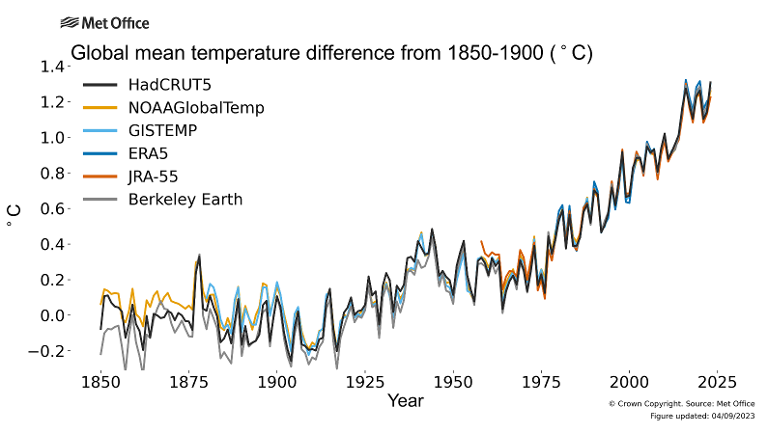Natural climate variability
Understanding the role of natural variability in our warming world
The evidence is clear: the world’s climate is warming. Globally, we have seen average temperatures at the earth’s surface warm by more than 1.1 °C over the past 160 years. (Using a methodology which includes projections alongside observations, research by the Met Office indicates the current global warming level could be as high as 1.26 °C). Most of this warming has taken place in the last 50 years. Although the global climate has changed in the past, current warming is occurring at over ten times the rate of warming after the last glacial period. Current warming is caused by increases in greenhouse gases in the atmosphere from human activities such as burning fossil fuels or changing how we use land.
Natural climate cycles
Natural climate cycles, such as the El Niño Southern Oscillation in the tropical Pacific, can temporarily affect global temperatures, raising or lowering them by fractions of a degree. More information on this can be found on our climate change questions page.
The rise and fall in sunspot activity can also affect global temperature, but by even tinier amounts. More information on the sun's impact on the climate can be found on our climate change questions page.
Thousands of years
Longer-term changes like Milankovitch cycles - which introduce shifts in the Earth’s orbit or degrees of tilt - do influence global climate over thousands of years, but they cannot explain the changes we have observed in the last 100 years.

Graph showing global mean temperature difference from 1850-1900
HadCRUT5 – Met Office Hadley Centre dataset; NOAAGlobalTemp – NOAA dataset; GISTEMP – NASA dataset; ERA5 – ECMWF dataset; JRA-55 – Japan Meteorological Agency dataset; Berkeley Earth - Berkeley Earth dataset
The misinformation you may encounter
- El Niño is responsible for temperature rise, not human-induced climate change
Our response: When it occurs, El Niño can temporarily raise global temperature by around 0.2 °C. This is sufficient to put a small and temporary spike on global temperatures, but this doesn’t account for the rise of 1.1 °C that the world has seen since the Industrial Revolution. (Using a methodology which includes projections alongside observations, research by the Met Office indicates the current global warming level could be as high as 1.26 °C). More information on this can be found on our climate change questions page.
- Sunspots are responsible for temperature rise, not human-induced climate change
Our response: A rise in sunspot activity changes global temperature by a tiny amount. When compared with greenhouse gas emissions its effect is very small. More information on the sun's impact on the climate can be found on our climate change questions page.
- Wobbles in the earth’s tilt and orbit are responsible for temperature rise, not human-induced climate change
Our response: Astrophysicist Milutin Milanković (sometimes referred to as Milankovitch) pioneered the study of these tilts and shifts. Over thousands of years these small movements do have an effect on earth’s climate by causing tiny changes to how much sunlight, and therefore energy, the earth receives. These cycles cannot explain the global temperature rise observed since 1850.
- There is no evidence for human-induced climate change
Our response: There is a significant amount of robust evidence that human activities have caused global warming. The majority of this evidence is published by the Intergovernmental Panel on Climate Change (IPCC) which remains the most authoritative and comprehensive assessment of climate change science.
In their most recent report, published in 2023, the IPCC stated, with high confidence: “Human activities, principally through emissions of greenhouse gases, have unequivocally caused global warming, with global surface temperature reaching 1.1 °C above 1850-1900 in 2011-2020.
"Global greenhouse gas emissions have continued to increase, with unequal historical and ongoing contributions arising from unsustainable energy use, land use and land-use change, lifestyles and patterns of consumption and production across regions, between and within countries, and among individuals.”
More questions?
For more answers to common questions about climate change visit our Climate Change questions page.


